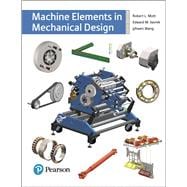The concepts, procedures, data, and analysis techniques needed to design and integrate machine elements into mechanical devices and systems.
Thousands of college students have used this book to learn about the principles and practices of mechanical design for over three decades—and many practicing engineers have either continued to use it in their careers, or newly discovered it as an invaluable resource in their work. The emphasis is on applying the technology of various machine elements while consistently considering those elements in the context of the larger machine of which they are a part. Appreciated for its readability, while recognized for its technical strength and comprehensive coverage of the material, Machine Elements in Mechanical Design is the ideal guide to the skills and knowledge needed for success in this field. Throughout, references to a broad array of available resources, from industrial sources and professional organizations, promote practical decision making in design and provide excellent preparation for moving from an academic environment to a professional position with strong, long-term growth potential. Continuing the book’s emphasis on proven approaches and the use of readily available materials, and its focus on practical, safe, and efficient design, this edition includes new content and adjustments contributed by the two new coauthors and features stronger technical content in stress analysis, a wider set of technical topics, and beautiful enhancements to the visual attractiveness of the book throughout numerous new full-color graphic illustrations.











